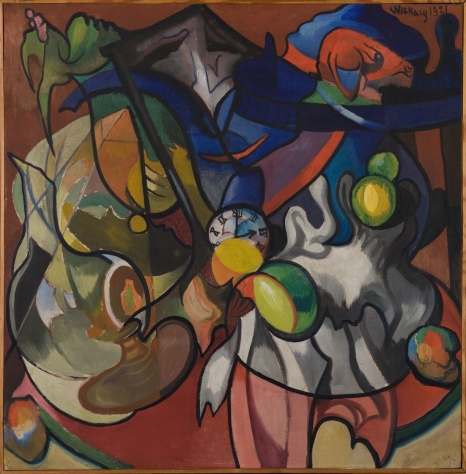
The company: Witkiewicz & Son
December 3, 2011 – January 22, 2012
concept: Anna Król, Lucyna Mizera
scenario and artistic arrangement of the exhibition, curator: Anna Król
commissioner on the part of the Regional Museum in Stalowa Wola: Monika Kuraś
Stanisław Witkiewicz and Stanisław Ignacy Witkiewicz
The Regional Museum in Stalowa Wola has prepared the first exhibition in Poland to present the artistic works of two extraordinary individualities of Polish art: Stanislaw Witkiewicz (1851-1915), painter, illustrator, art critic, creator of the Zakopane style – and his son, Stanislaw Ignacy, known as Witkacy (1885-1939), who, in addition to avant-garde painting, created extraordinary dramas and novels, and was also involved in philosophy, photography, art theory and criticism.
This exhibition will begin unusually, as it will not have an opening. Instead of the official opening, the ceremonial presentation of the exhibition to all those who wish to visit it within the framework of the “Sztukobranie” series is planned only during the weekend of January 13-14, 2012, while from Saturday, December 3, the exhibition can already be visited under normal conditions.
Stanislaw Witkiewicz (father) was a charismatic figure with tremendous power of influence. His essays, reports (including On the Pass. Impressions and Images from the Tatra Mountains) and letters inspired, made people think and provoked discussions. Since 1895, he settled permanently in Zakopane, running an open house where aristocracy, writers, musicians, painters, scholars, doctors, politicians, mountaineering athletes and mountaineers frequented. He was the creator of the Zakopane style, which was to encompass all genres of art. According to Witkiewicz’s design, the Zakopane villas Koliba, Pepita, Pod Jedlami and Oksza were built in this style.
Stanislaw Ignacy Witkiewicz “Witkacy” lived in Zakopane during the interwar period, participating intensively in artistic life. He was known for his endless number of jokes and absurd actions, and participated in controlled drug séances. He published an essay New Forms in Painting and the Resulting Misunderstandings, where he presented his own theory of Pure Form. In his early period, he painted landscapes, still lifes and portraits under the influence of Slevinsky and in the spirit of Young Poland; later, in fantasy-grotesque paintings, he arrived at abstract expressionism. In 1925, he withdrew from painting, from the concept of Pure Form, and established a for-profit, one-man “Stanislaw Ignacy Witkiewicz Portrait Company,” operating according to specifically established regulations.
– The exhibition presents paintings, watercolors, pastels, drawings and photographs from different stages of the work of both artists, showing two evocative, different visions of art and the world, reports the exhibition’s curator, Anna Król. – It is nearly 100 paintings from more than a dozen museums, including, on the one hand, rarely shown works by both artists, and, on the other hand, those that adorn permanent exhibitions in the best Polish museums and practically never leave them.
Witkiewicz-father’s works include portraits of: Helena Modrzejewska, Henryk Sienkiewicz, Sabała, his son’s portrait and self-portrait, caricatures: Stefan Żeromski and Jan Gebethner, atmospheric Tatra landscapes (On the Rysy Mountains Halny wind, Tatra forest in the snow), views from Cracow (Wawel from the side of the Vistula River, Street market on the corner of the Cracow Market), genre scenes (Funeral in the countryside, Six paintings from village life).
Witkacy is represented at the exhibition by numerous portraits (including Eugenia Dunin-Borkowska, Henryka Soroko-Labordaire, Maria Znamierowska-Prufferowa, a self-portrait), as well as works of various themes and forms (e.g. Temple of the Deity of Absolute Nothingness, Fantastic Vision, Witches’ Sabbath). A separate chapter is the “Gębozbiór” – a series of original photographs, documenting “mines.”
The juxtaposition of such rarities in one place is a special treat for art lovers, while the comparison of the different creative personalities of father and son is part of the series initiated by the exhibition of Jacek and Rafał Malczewski, and the motto of the Witkiewicz exhibition is:
The customer must be satisfied.
Disagreements excluded.
The exhibition is accompanied by a catalog-album by Anna Król, graphic design. Rafal Sosin.
Works of art for the exhibition were lent by:
Jacek Malczewski Museum in Radom, Mazovian Museum in Plock, National Museum in Krakow, National Museum in Poznan, National Museum in Szczecin, National Museum in Warsaw, Leon Wyczółkowski District Museum in Bydgoszcz, District Museum in Torun, Podlaskie Museum in Białystok, Silesian Museum in Katowice, Dr. Tytus Chałubiński Tatra Museum in Zakopane, District Museum in Rzeszów, Stanislaw Staszic Pomeranian Bookstore in Szczecin.